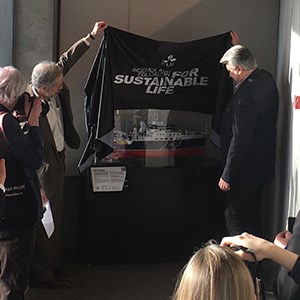Sweden’s new research vessel at Skansen and Havets Hus

Now you can see, and visit, Sweden’s new research vessel Svea at Skansen in Stockholm and Havets Hus in Lysekil. SLU has lent model ships and created a virtual tour of the vessel that make this possible. A seminar was arranged when the model was handed over to Skansen. Researchers from SLU and SMHI talked about the new possibilities they have with one of the world’s most modern, silent and environmentally friendly ships.
When R/V Svea was delivered in the summer of 2019 she was the first Swedish oceangoing research vessel in 45 years. Very few people have an accurate idea of what a modern research vessel is. So far more than 1,500 persons have visited Svea for real, but that opportunity is limited. Svea should ideally spend as much time as possible at sea performing research and environmental monitoring.
Visit the wheelhouse, the sauna, and the galley
With models at two very popular attractions, more people can get to know about the vessel and see it with their own eyes. The virtual tour, available via a touch screen, allows the visitors to look around in the vessel. Even parts of the ship, which for practical reasons, cannot be shown at a port visit. The engine room is maybe the most requested part of the vessel but why not take a look into the vessel’s galley and the ship sauna. Or take advantage of the opportunity of being alone in the wheelhouse.
Floodlight instead of a torch
Seven surveys have been done with Svea so far. During the seminar at Skansen’s Baltic Sea Science Center at Skansen, Joakim Hjelm, a researcher at SLU’s department of aquatic resources (SLU Aqua) Talked about the important improvements that the vessel brings with it.
”Svea is like a powerful floodlight where we used to have a torch. The acoustic abilities are in the research forefront. With echo sounders we can study monkfish and other bottom-living fishes, we can see what is going on at the coastline and for example distinguish diving birds from fishes and shoals. Last autumn we found new fish species that we have never seen in our waters before. With Svea, we can understand why they have appeared now.”
”We can also follow zooplankton and climate change, not least through our cooperation with SMHI and using the data they collect. In this way, Svea becomes a crystal bowl showing what the future may look like.”
Long data series and microscopic plankton
Lars Arneborg is responsible for SMHI’s oceanographic department. In the same seminar, he talked about SMHI’s data series that go a hundred years back, and how they use Svea a week every month to measure parameters like oxygen levels and salinity, as well as the occurrence of planktons at different depths.
A new source of knowledge for SMHI is an automatic lab for water analysis, a so-called Ferrybox. It measures properties, like chlorophyll levels and amounts of plankton, at a depth of a couple of meters while the vessel is moving between sampling stations. Expectations are high on the new system.
Lars Arneborg also talked about alternative scenarios for oxygen concentration at the Baltic seabed. We can expect a slow improvement in all scenarios except the worst one with major climate change and large emissions of nutrients. SMHI is working on further improvements of their models, not least taking advantage of the knowledge the collect using Svea.
Aquariums, fishes and many visitors
Havets Hus is located in Lysekil, Svea’s home port. It is one on Bohuslän’s most popular attractions, with 80 000 visitors every year. And it is also one of very few organisations that reintroduces sharks into the wild. It is also a natural place to display Svea since it is also located only a stone’s throw from SLU’s Institute of Marine Research. Havets Hus was expanded and renovated in 2019 so the model of Sweden’s most modern research vessel has come in place at the right moment.
Baltic Sea Science Center at Skansen in Stockholm, premiered in April 2019. It displays different Baltic environments from coastal to offshore. The pedagogic activity and the scientific foundation are important aspects. SLU stands, together with Stockholm University, for the academic knowledge that is communicated and SLU has collected most of the fish. Since its opening, more than 500 000 people have visited and during 2020 they are hoping that 500 school classes will visit. There is no other place where Svea can be shown to that many persons. And it’s even more fitting since Svea will be used to collect fish that will end up at Baltic Sea Science Center.